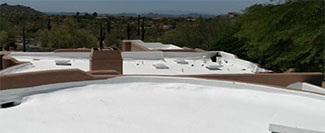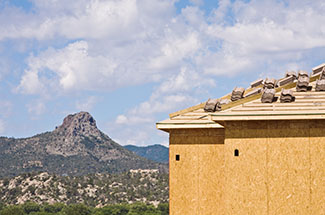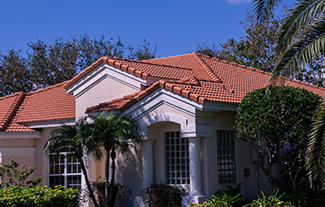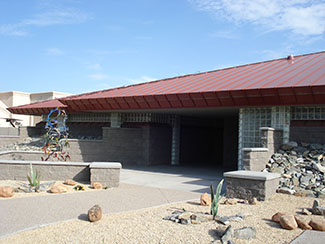Rosie's Roofing Consumer Guide
Roofing Consumer Guide
Download Roofing Consumer Guide PDF
On those rare occasions when it rains in Arizona and you have a leak, you may wonder if you need a brand new roof, especially if your house is 10 to 15 years old or more.
During the past few years, many new roofing products have come on the market. Suddenly, choosing materials can get very complicated in a hurry.
As for cost estimates, much more is involved than the materials alone. Every home has issues that raise the price: What kind of access is there to your roof? How many sheets of underlayment are beneath shingles or tiles? Can you lower the old roofing materials easily onto the ground? Are there electrical wires to watch for? Is the roof more than 15 feet high?
Another unknown is the condition of your roof deck. Are there rotten wood or joists under shingles or tiles?
Following are advantages and drawbacks of various types of roofing:
Flat Roofs:
Flat roofs are usually easier to repair or replace than pitched roofs, and the roofing options are more limited. Many houses in Arizona have both flat sections as well as pitched areas.
1 | Foam:
Foam covering has become increasingly popular because it provides the best protection for flat roofs and is easy to work with. It covers a roof completely with no seams or joints to split open and create leaks. But birds can peck holes in the foam that will lead to leaks and water damage.
Foam costs about 10 percent or more than what is called built-up roofing, and that doesn't include what it costs to tear off an old roof. If your current built-up flat roof is in good condition, foam can be laid over it if special technical preparations are taken at the parapets and for the roof penetrations.
You definitely get what you pay for with foam. It insulates your home so your energy bills can be lower; it's lightweight and can almost last forever. Its light color reflects the sun. One disadvantage: It must be inspected every five to seven years to ensure that the elastomeric covering on top is not wearing thin. That covering has to be redone regularly so that the foam does not get "sunburned." If a foam roof has sun damage, you need a complete foam replacement.
2 | Built-Up Roofs:
This less-expensive style of flat roofing features membrane sheets with sealing on seams as well as around vents, pipes and other penetrations sticking up from the roof. Sometimes it's called a modified bitumen roof. Basically, it's rolled asphalt with heat applied to make it stick to the roof. It can be covered with elastomeric material and generally needs replacing every 15 to 20 years.
3 | PVC:
PVC stands for polyvinyl chloride. It is used to make flexible plastic sheets that are heat-welded together on your roof. This single-ply roofing, sometimes sold under the brand names Dura-Last or IB, can cost at least 20 to 30 percent more than foam and takes a week to install. It is longer lasting than foam and comes in tan or light colors; it resists heat and is very energy-efficient. It is installed on a roof over rigid boards of insulation material. Some estimates are that a PVC roof will last 30 years. It does not need regular recoatings.

Pitched Roofs:
When a pitched roof is covered with clay or concrete tile, it can be difficult to determine what shape your roof is in without an inspection. That's because the tiles are not really the actual roof; it's the underlayment of felt under the tiles that keeps out the rain. To check the underlayment, a roofing firm will inspect the valleys on your roof or areas near the chimney and pull up a few tiles. Although many types of tiles can last 20-30 years or more, the underlayment has to be replaced more often.
Many homeowners may not like the roofing that they have, but making a major change can involve obstacles. In a subdivision where all homeowners have the same roofing, HOA rules forbid a change in style. Going from wood shakes or fiberglass shingles to tile would require a major redo of the frame of your house to support the increased weight of the tiles.
1 | Clay Tile:
Several kinds of clay tiles are marketed in Arizona, including sandcast, two-piece, interlocking and flat. Sandcast is a matte-finished, rustic-looking tile popular for use on high-end homes, for example. Two-piece tile is similar but stronger. Remember that clay tile will last longer if the underlayment is high quality. The best roofers recommend an underlayment of two layers of 40 pound felt as well as modified bitumen roofing in valleys. Another high-quality choice is G-40, a rolled bitumen material, for the entire roof.
In any case, you will probably have to replace your underlayment before you replace the tiles. How would that be done? Generally, if tiles are in good shape, your contractor can remove them and put them back after replacing the underlayment. Roofers call this an R and R for "remove and replace."
One possible glitch: If some tiles are broken and can't be reused, you may have trouble finding replacement matches. In part that's because over the past few years, many clay tile companies went out of business in Arizona. If you have to replace missing tiles with a slightly different color, however, a roofer can install them in spots where they are not easily visible.
Although clay tiles are long lasting, they can break and crack, as happened in a massive hailstorm a couple years ago. They can also shatter if someone walks on them while doing repairs.
2 | Concrete Tile:
Concrete tiles are even more indestructible than clay and can last for dozens of years, local roofers say. But these tiles face the same trouble as clay with underlayment. They also can be removed and replaced. Both clay and concrete are fireproof and resist rot and insects.
3 | Wooden Shakes:
Wooden shakes are not common in Arizona, particularly in desert regions. In general, except for important architectural considerations, we do not recommend use of wood shakes.
4 | Metal:
A newly popular option is metal roofing. One style is made of steel coated with bits of stone so that individual units look like clay tile or wood shakes. These roofs are much lighter than clay or concrete and can sometimes be installed over other roofing. They are durable and will not crack, break, curl or fade. They are laid on top of a structure of 2-by-2s because there has to be air flow between the roof below and the metal paneling.
5 | Shingles:
Fiberglass shingles can last 20 years or more but have been rising in price. Since these shingles are partly coated with asphalt, an oil refinery byproduct, their cost has gone up due to the cost of oil. Asphalt shingles are lightweight, won't break when you walk on them and carry fire ratings. But shingles can blow off during a storm; they tend to absorb heat and discolor in the hot sun.
When hiring a roofing contractor, just as when you hire anyone to work on your home, be sure that person is licensed, bonded and insured. Be sure the license is valid, not expired and check expiration dates on your contractor's bond and insurance as well. Get the contractor's state license number and verify his record with the Arizona Registrar of Contractors. You can do that by visiting www.azroc.gov and clicking on "contractor search."
All this is especially important after large storms when "storm chasers" come to Arizona. You want a roofer who will be here for the long term and will guarantee their work.
Download Roofing Consumer Guide PDF
###
